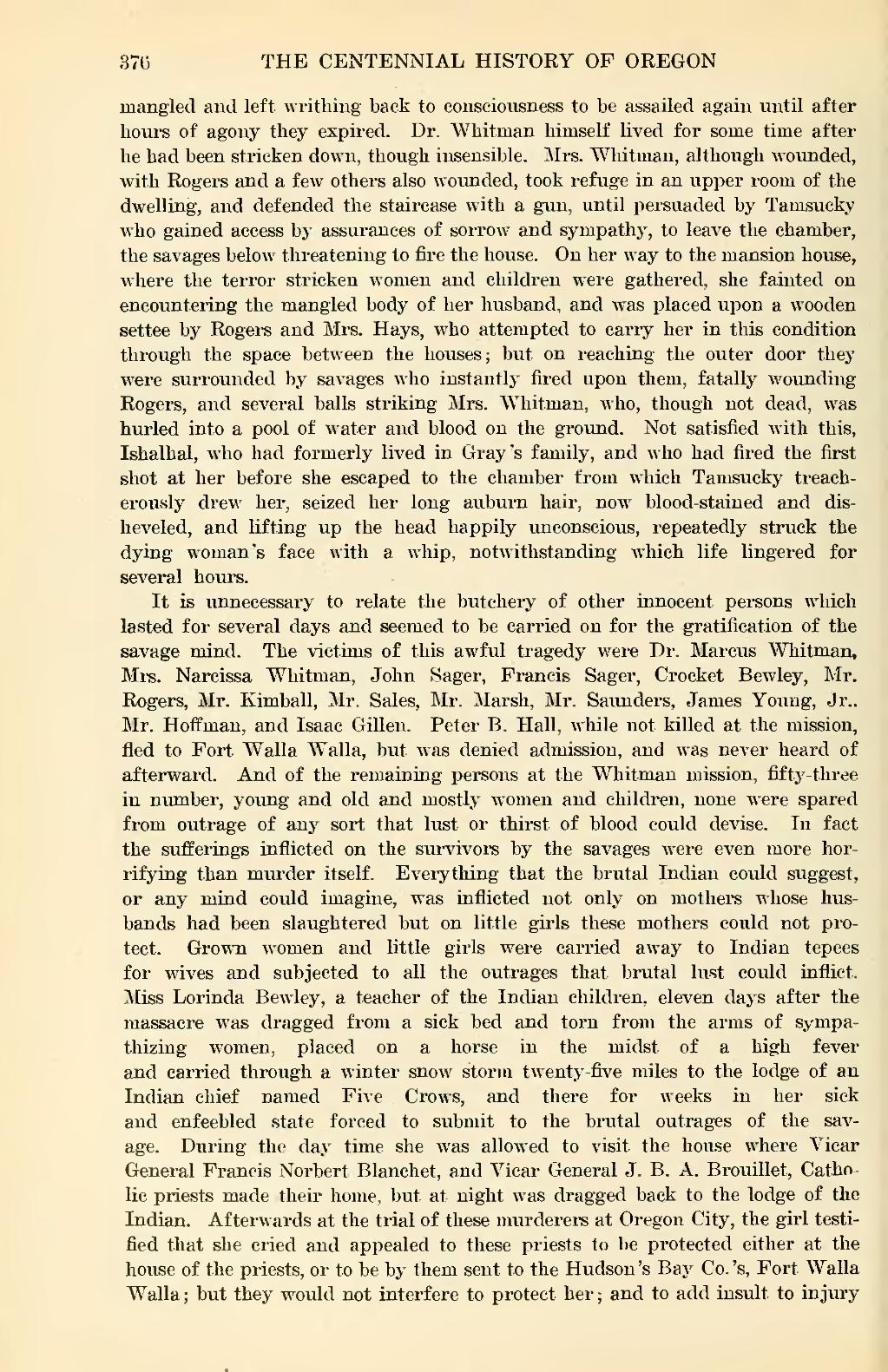mangled and left writhing back to consciousness to be assailed again until after hours of agony they expired. Dr. Whitman himself lived for some time after he had been stricken down, though insensible. Mrs. Whitman, although wounded, with Rogers and a few others also wounded, took refuge in an upper room of the dwelling, and defended the staircase with a gun, until persuaded by Tamsucky who gained access by assurances of sorrow and sympathy, to leave the chamber, the savages below threatening to fire the house. On her way to the mansion house, where the terror stricken women and children were gathered, she fainted on encountering the mangled body of her husband, and was placed upon a wooden settee by Rogers and Mrs. Hays, who attempted to carry her in this condition through the space between the houses; but on reaching the outer door they were surrounded by savages who instantly fired upon them, fatally wounding Rogers, and several balls striking Mrs. Whitman, who, though not dead, was hurled into a pool of water and blood on the ground. Not satisfied with this, Ishalhal, who had formerly lived in Gray's family, and who had fired the first shot at her before she escaped to the chamber from which Tamsucky treacherously drew her, seized her long auburn hair, now blood-stained and disheveled, and lifting up the head happily unconscious, repeatedly struck the dying woman's face with a whip, notwithstanding which life lingered for several hours.
It is unnecessary to relate the butchery of other innocent persons which lasted for several days and seemed to be carried on for the gratification of the savage mind. The victims of this awful tragedy were Dr. Marcus Whitman, Mrs. Narcissa Whitman, John Sager, Francis Sager, Crocket Bewley, Mr. Rogers, Mr. Kimball, Mr. Sales, Mr. Marsh, Mr. Saunders, James Young, Jr., Mr. Hoffman, and Isaac Gillen. Peter B. Hall, while not killed at the mission, fled to Fort Walla Walla, but was denied admission, and was never heard of afterward. And of the remaining persons at the Whitman mission, fifty-three in number, young and old and mostly women and children, none were spared from outrage of any sort that lust or thirst of blood could devise. In fact the sufferings inflicted on the survivors by the savages were even more horrifying than murder itself. Everything that the brutal Indian could suggest, or any mind could imagine, was inflicted not only on mothers whose husbands had been slaughtered but on little girls these mothers could not protect. Grown women and little girls were carried away to Indian tepees for wives and subjected to all the outrages that brutal lust could inflict. Miss Lorinda Bewley, a teacher of the Indian children, eleven days after the massacre was dragged from a sick bed and torn from the arms of sympathizing women, placed on a horse in the midst of a high fever and carried through a winter snow storm twenty-five miles to the lodge of an Indian chief named Five Crows, and there for weeks in her sick and enfeebled state forced to submit to the brutal outrages of the savage. During the day time she was allowed to visit the house where Vicar General Francis Norbert Blanchet, and Vicar General J. B. A. Brouillet, Catholic priests made their home, but at night was dragged back to the lodge of the Indian. Afterwards at the trial of these murderers at Oregon City, the girl testified that she cried and appealed to these priests to be protected either at the house of the priests, or to be by them sent to the Hudson's Bay Co.'s. Fort Walla Walla; but they would not interfere to protect her; and to add insult to injury
